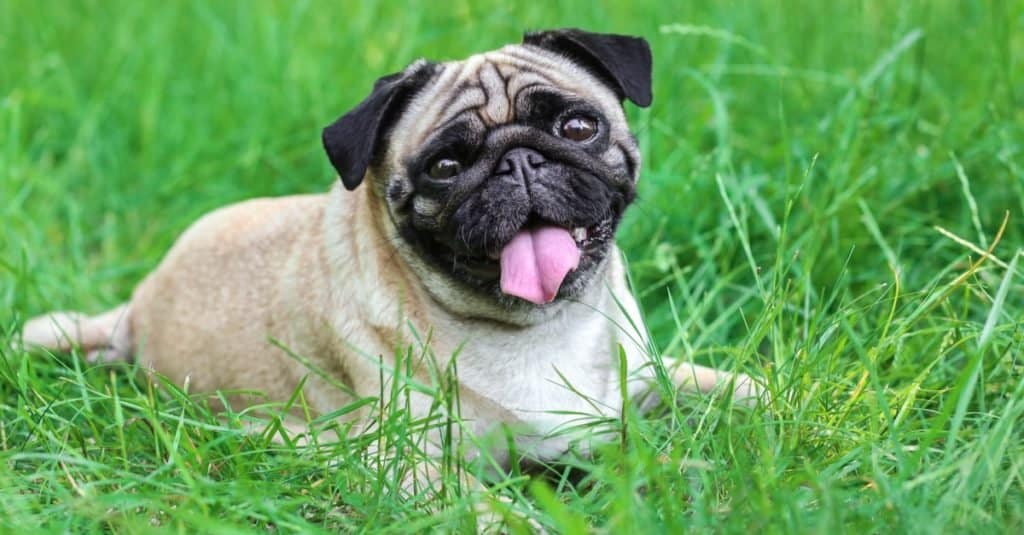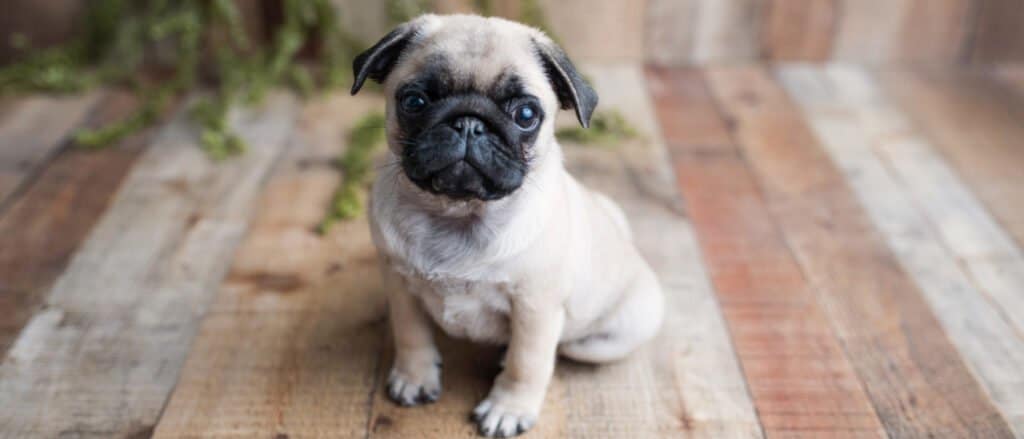So, you just brought home a tiny, adorable pug puppy and you’re now wondering — where do I start? Rest assured, we’re here to bring you the top pug training tips, common mistakes to avoid, and an average timeline for training.
Are Pugs Easy to Train?
On one hand, pugs are very smart and love to please their owners. But on the other hand, they can be energetic, stubborn, and playful when they should be listening. This puts pugs right in the middle when it comes to training. Sure, there are a few breeds that are easier to train, but there are also breeds that are harder to train. The key to training a pug is knowing how to train and praise them.
The three best methods for training a pug are: using positive reinforcement, offering treats, and having patience.
Bringing Home Your Puppy

Pugs love positivity, and really dislike and fear negativity. Discipline will not work nearly as well as positive reinforcement.
©YakobchukOlena/ via Getty Images
When you bring your pug home, it’ll usually be around 8 to 10 weeks old. During these first few months with your puppy, there are a few things you’ll need to teach them.
Your first step is pretty fun: choose a name for your pug! Once you choose their name, try your best not to change it. You’ll use their name repeatedly to help them associate it with themselves. Their name will also help you call them to you. We recommend coming up with a name that isn’t too long, or at least shortening lengthy ones like “Sir Barks-A-Lot” to “Sir” or “Barky” if you can.
Once you’ve come up with a name, say it often and with a happy voice. Try to avoid using your dog’s name when scolding them — instead, just say ‘no’ in a firm voice. You want their name to only be associated with happy things, like your happy voice and treats. Another tip: pugs LOVE food, and by food, I mean human food. Offer them a cut of chicken or a slice of cheese after you call their name, and they’ll likely come right back again!
Setting a Schedule and Potty Training
Unless you get really lucky, your puppy probably won’t come potty trained. But that’s alright because pugs are about as easy to potty train as any other breed. Their stubbornness may play a part in some of the accidents they have around the house, but their quick learning skills help make up for it. The timeline for potty training a pug is usually only a few weeks to a few months, as they catch on pretty quickly.
The best tip for helping potty training go smoothly is to speak to your dog in a high-pitched, happy voice once they’ve pottied outside. It helps them realize that they did what you asked. You can also repeat the word ‘potty’ in a high-pitched, happy tone while they are pottying to reinforce the action.
Another trick for helping potty train your pug is crate training. Dogs do not like to potty where they sleep, especially since a crate is such a small space. Training your pup to stay in a crate at night and/or while you’re away can help speed up the process of potty training.
Pug Training Tips

Find a quiet room or go to a calm outdoor space without other animals to work on training your pug.
©Africa Studio/Shutterstock.com
When it comes to pugs, the biggest thing to remember is that they’re stubborn yet loving. They want to do what you’ve asked, but they have so much energy and excitement that they often get distracted! One way to combat this is by doing training sessions (specifically with command training) in a quiet, distraction-free area. This might be a room in your home with no other people and no noises, or a quiet area outside that’s free from other pets. You will eventually want your pug to listen to you regardless of distractions, but it will be easier for them to learn commands in a distraction-free area.
Common Mistakes

Start training your pug while it’s still young, but not too young.
©TanyaCPhotography/Shutterstock.com
Something that many owners don’t realize before adopting a pug is that they require regular grooming. They may be short-haired, but they still shed and require regular bathing and brushing. On top of that, you will also need to clean the wrinkle around their face, which is often needed daily. Pugs don’t always love grooming, so you can sweeten the deal by offering snacks they don’t usually get to eat.
Another common mistake with pugs is trying to train your puppy commands too early. For the first few weeks of having your puppy home, you should really be concentrating on getting to know your pet, teaching them their name, and potty/crate training. Pugs are ready to start obedience classes or begin command training (sit, lay down, etc.) by around 16 weeks or older. You also don’t want to wait too long and let them learn too many bad habits. Around 4 to 5 months is usually the sweet spot to begin command training your pup.
How Do You Train an Adult Pug
Most of our training tips apply to puppies, but what if you adopt an older pug who still needs training? Well, it may be a bit more difficult, but training an older pug is not impossible. The most crucial thing to know is that pugs do not respond well to harsh words or negativity. You will have to maintain patience and a calm voice — even when your pug refuses to listen. Adult pugs may have bad behaviors that you will want to correct. It’s important to remember that their behaviors weren’t learned in a day, and they also won’t be corrected that quickly.
Most of all, know that training a pug is possible at any age, but it requires hard work and patience. Pugs are stubborn — but they are loveable, fun, and quirky little pups that you will love a little more each day!
The photo featured at the top of this post is © fongleon356/iStock via Getty Images
Ready to discover the top 10 cutest dog breeds in the entire world?
How about the fastest dogs, the largest dogs and those that are -- quite frankly -- just the kindest dogs on the planet? Each day, AZ Animals sends out lists just like this to our thousands of email subscribers. And the best part? It's FREE. Join today by entering your email below.
Thank you for reading! Have some feedback for us? Contact the AZ Animals editorial team.






